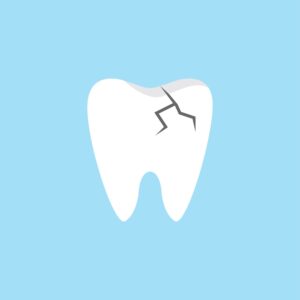Your teeth are strong, durable fixtures within your mouth that bite, tear, grind, and chew food. Normally, teeth endure this wear and tear without issue, but under high levels of pressure, a tooth might accidentally chip, crack, or fracture. If this occurs, the tooth could be in danger of decay, infections, and other problems.
You will need to see your dentist right away in the event of a broken tooth. Unlike bones, teeth cannot heal on their own. Call your dentist for an emergency evaluation and swift treatment of a fractured tooth.
You can feel more confident reaching out to your dentist when you know more about tooth breakage and its potential consequences. Read on to learn more about this dental injury, including symptoms and treatments.

Signs of a Broken Tooth
When you fracture a tooth, you can often see a visible chip or crack in the surface of the tooth. Without urgent treatment, this breakage will deepen and worsen. You may even see dark discoloration near the dental injury.
Oftentimes, the primary indicator of a tooth fracture is oral pain. You might feel a constant toothache that worsens when you bite or chew on that tooth. Intermittent sharp, throbbing pain could also point to a broken tooth.
Patients with a fractured tooth may also feel tooth sensitivity. This happens because the protective enamel sustains damage that exposes underlying nerves within the tooth. Stimulation from external elements touches these nerves which generates tooth sensitivity pain. Pain of any kind is abnormal and will warrant attention from a dentist.
You might also see swelling in the mouth and jaw near this dental injury. However, sometimes a tooth fracture does not exhibit noticeable symptoms at all. Contact your dentist if you suspect you broke a tooth to ensure you receive the treatment that you need.
Treatment Options for a Dental Fracture
Treatment may vary depending on the severity of your dental fracture. The dentist will perform a visual exam of the injured tooth, but they will also want to use x-ray imaging to determine how deep the fracture goes into the tooth.
A crack in the cusp, the visible portion of the tooth above the gumline, might require a dental crown to cover and shield the injury. This will restore the appearance and function of the tooth while also stopping further harm from impacting the tooth.
A fracture that extends to the root of the tooth below the gumline will need more extensive treatment from your dentist. They may need to do root canal therapy to stop the injury from worsening.
More severe injuries that affect the root of the tooth might require extraction of the tooth. In some cases, the dentist might only need to remove part of the tooth, but you may need the entire tooth pulled to stop damage from spreading to other places in your mouth.
Discuss your oral health goals as well as your smile aesthetic preferences with your dentist. This way, you can find the best restorative dental solution for your unique smile.
